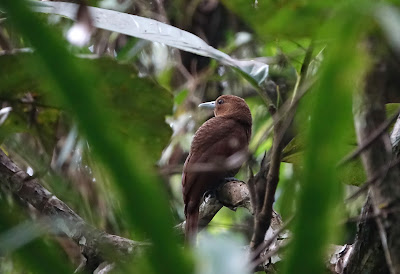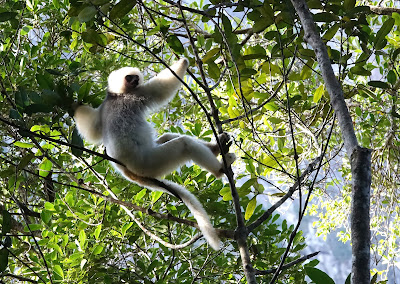This is the final blog post of our trip to Madagascar. Although we had another week or so after Marojejy, it wasn't particularly birdy, although Ankarana NP was OK for both birds and lemurs, e.g. a trio of White-breasted Mesite were seen, as were Golden-crowned Sifaka. I'm also way behind on our recent trip to Philippines and Borneo, so these must now take priority.
4th October
Following on from our brilliant time in Andasibe, Emily and I caught a 90-minute flight up to Sambava, where my initial contact, Eugene Rakotobe, greeted us at the exit door. Once we'd cleared the scrum of the now desperate taxi drivers, we set off west towards the mountains, stopping off for a coffee on the edge of town, which for some reason took many lifetimes to arrive, but eventually did and was deemed 'not worth the wait'. On the drive, our driver was in fact the highlight, having a strange mechanical voice having us in stitches for some time before the novelty wore off; his name was Kristoff and was a pleasant chap.
The journey to Marojejy HQ was around two hours, but we did stop off at a viewpoint for a view of the mountains, with a Hognose Snake at our feet being the most exciting sighting. It was soon time to arrive at HQ, meet our guide (Franko), shed our load of gear and set off to the local village where our hike would commence. A quick word on Franko - he was excellent, spoke good English, knew the park well and was interested in many aspects of wildlife, especially herpetology, which for this specific region, proved invaluable.
The first four kilometres were through farmland and cultivations (Vanilla plantations) where Emily was soon finding her own chameleons (I never found one the entire time) after Franko found the first, while I was repeating as courteously as I could the need and desire to see a Helmet Vanga (I think the point had been well and truly drilled in before we'd even hit the forest proper). We entered the park officially and made our way up to Camp 1 where the birding was generally quiet, although a few bird flocks kept us entertained, although a prolonged view of a perched Cuckoo-roller was the highlight. Along the walk a natural pool was very welcome for us, as was a cup of tea when we reached camp.
 |
| White-lipped Frog |
 |
| young Parson's Chameleon |
 |
| Eastern Red Forest Rat |
 |
| our plane to Sambava |
 |
| Marojejy Massif |
 |
| Beginning of the 6km trek to Camp 1 |
 |
| Natural Pool/Bath at KM4 |
 |
| Our accomm at Camp 1 |
5th October
Currently unbeknown to us as we awoke to a fine morning, today was to be a quite excellent day! We were all up at the crack of dawn and had a light breakfast before venturing down the Humbert Waterfall trail, accessible from this campsite. The outbound journey was relatively quiet, finding the usual Blue Coua and some roosting bats. We had reached the waterfall rather quickly due to little activity, but the presence of two Hook-billed Vangas here was a sign of our return journey. It began with a roosting White-browed Owl, then a small flock comprising White-throated Oxylabes, Spectacled and Grey-crowned Tetraka, then a vanga flock a short while later contained not only Tylas Vanga, but the hoped for White-headed Vanga. The latter species was critical in finding the main target as this is a typical carrier species, and after a tense wait, a large shadow arrived above our heads, revealing itself to be the unmistakable Helmet Vanga!!! Few words can do this bird justice, it's simply out of this world and now two birds had the decency to hang about (as they so typically do) while we gawped with amazement. Our views couldn't have been better and after 45-minutes of viewing, we ventured back to camp for a second breakfast and to regain some form of normality after such an amazing experience.
Between here and Camp 2 (2km) we again had amazing luck: a Red-breasted Coua was a lucky sighting, we saw some cool frogs, but perhaps best of all, was an uber-rare snake named Liophidium pattoni, a species only discovered in 2010 and has maybe been seen by only a handful of people.
Once we arrived at Camp 2 and admired the views from the nearby waterfall (the top roped off due to a supposed thrill-seeker having fallen and died some years back), we set off to find one of the country's rarest lemurs, the Silky Sifaka. Marojejy is now the only reliable site for this species; with this and it being Madagascar's second largest lemur, we were very keen to see a family. Helpfully, local trackers keep an eye on them and after a mega steep descent through tangles (disturbing a female Bernier's Vanga in the process), we clocked eyes on the Silky Sifakas. Despite the book making them out as rather ugly animals, in real life they are true stunners and completely out of place in the green forest - it's thought the family of four is perhaps 5% of the world population! We observed these gentle creatures until the sun started to set, them nodding off on their chosen branches.
Back at the camp, after dinner a short walk around the site revealed some roosting Eastern Bamboo Lemurs and more active Woolly Lemurs.
 |
| Helmet Vanga |
 |
| White-throated Oxylabes |
 |
| White-browed Owl |
 |
| Liophidium pattoni |
 |
Brown Leaf Chameleon
|
 |
| Madagascar Cuckooshrike |
 |
| Silky Sifakas |
 |
| female Bernier's Vanga |
 |
| Climbing Mantella |
 |
| Humbert Waterfall looking downriver |
 |
| Camp 2 |
 |
| views from Camp 2 |
6th OctoberWe were offered to trek to the summit of Marojejy, but thankfully our foresight of how tough a trek this could have been meant we instead opted for a tough ascent to Camp 3, birding as we went, and returning to Camp 2 to overnight. Due to our earlier successes, the list of potential targets we could have seen was greatly reduced, but there were still a few outstanding and an ascent to higher climes would aid us in tracking down the remaining few.
A dawn until breakfast scan of the area was very good, with Alpine Swifts and Madagascar Buzzards patrolling the skies, while a Cryptic Warbler, Rand's Warbler, Green Jery and Velvet Asity were seen/heard and Eastern Bamboo Lemurs were happily tucking into their breakfast, of... bamboo!
After breakfast, it was a near-vertical ascent, therefore, birding was limited to observing a few metres in front of us, though this did mean we saw a few cool frogs. Once the terrain had levelled off, we came across a couple more White-headed Vangas with a brief Helmet Vanga also tagging along. Madagascar Brush-warblers were being particularly frustrating with not being in prime habitat and a lovely flock of Blue Vanga also appeared. There were very few flowering trees, but those that did had a couple of female Common Sunbird Asity around them. We finally arrived at Camp 3 in time for lunch, but a large low-feeding bird flock quite rightly took our attention, containing the hoped-for Wedge-tailed Jery, plus Long-billed Bernieria, Grey-crowned Tetraka and Red-tailed Vanga.
It was then time to return back to Camp 2, keeping a close eye on any flowering trees along the way, which thankfully produced a sublime Yellow-bellied Sunbird Asity, although it was a brief sighting meaning no photos of this relatively identical species to its cousin. Other than Dark Newtonias, the return journey was quiet and we arrived with beaten-up knees and feet are a tricky descent. It was then time for a natural bathe, dinner and then a nocturnal walk which produced two mega leaf-tailed geckos, the Giant, and even rarer, Lined.
 |
| The Waterfall View |
 |
| Eastern Bamboo Lemur |
Leaf Frog sp.
 |
| view from near Camp 3 |
 |
| Green-backed Mantella (female) |
 |
Giant Leaf-tailed Gecko,
taken by Emily |
 |
| Lined Leaf-tailed Gecko, taken by Emily |
7th OctoberWe desperately didn't want to leave this amazing park, therefore, we retraced our steps back to HQ today as slowly as we could. We again birded the Camp 2 grounds seeing most of the same stuff, then after breakfast, almost crawled the six kilometres to the starting point. Franko and Emily went searching mostly for chameleons and frogs, whilst I remained birding and between us we had some excellent sightings, including the second smallest chameleon in the world, a chameleon named after the park, two more incredible Helmet Vanga including one on a nest (expertly spotted by Franko), a pack of White-fronted Brown Lemurs, a Madagascar Sparrowhawk perched above a stream and oddly our first Madagascar Green Pigeons of the trip! Lastly, an incredibly tame Ring-tailed Vontsira (mongoose) graced our presence for maybe 15-minutes. Our final KM was again through the paddies until we arrived back into the village, greeted by the waving children. Somehow it had taken us approximately eight hours to walk the six kilometres!!
Kristoff and Eugene were ready to greet us and we drove back to Sambava where a fine hotel was waiting for us, a relief after camping, but it somehow felt wrong to have such luxuries, having had some truly memorable moments while living a rustic lifestyle!
 |
Madagascar Dwarf Chameleon
(the second smallest in the world) |
 |
| Helmet Vanga |
 |
| White-fronted Brown Lemur |
 |
| Ring-tailed Vontsira |
 |
| Helmet Vanga |





































